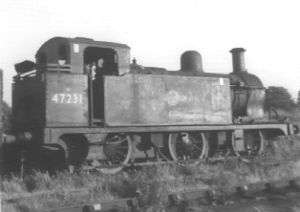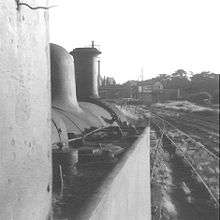Midland Railway 2441 Class
The Midland Railway (MR) 2441 Class was a class of steam locomotive. Introduced by Samuel Johnson in 1899, originally with round-topped fireboxes. Henry Fowler later rebuilt them with Belpaire fireboxes. They were given the power classification 3F. The LMS Fowler Class 3F of 1924 was based on this design.
| Midland Railway 2441 Class | |||||||||||||||||||||||||||
|---|---|---|---|---|---|---|---|---|---|---|---|---|---|---|---|---|---|---|---|---|---|---|---|---|---|---|---|
 47231 at Whitacre in 1964, just before scrapping (hence the lack of coupling rods). | |||||||||||||||||||||||||||
| |||||||||||||||||||||||||||
| |||||||||||||||||||||||||||
| |||||||||||||||||||||||||||
| |||||||||||||||||||||||||||

Numbering
Sixty locomotives were built. Initially numbered 2441–2460, 2741–2780; they were renumbered 1900–1959 in the Midland Railway's 1907 renumbering scheme. All passed to the London, Midland and Scottish Railway, initially retaining their MR numbers, before being renumbered 7200–7259 between 1934–1937. All passed into British Railways ownership in 1948 and were numbered 47200–47259.
Withdrawal
Withdrawals started in 1954, with three locomotives still in service on 1 January 1966. All were scrapped, though several later LMS locomotives have survived.
| Year | Quantity in service at start of year | Quantity withdrawn | Locomotive numbers |
|---|---|---|---|
| 1954 | 60 | 2 | 47244–45 |
| 1955 | 58 | 4 | 47232/37/52–53 |
| 1956 | 54 | 4 | 47215/20/33/56 |
| 1957 | 50 | 7 | 47206/22/27/40/42–43/58 |
| 1958 | 43 | 3 | 47234/49/51 |
| 1959 | 40 | 9 | 47205/08/10/14/16/19/26/46–47 |
| 1960 | 31 | 5 | 47203/29/38/41/54 |
| 1961 | 26 | 8 | 47200/04/09/12/18/21/39/55 |
| 1962 | 18 | 5 | 47213/17/24/35/59 |
| 1963 | 13 | 2 | 47225/48 |
| 1964 | 11 | 7 | 47207/11/23/28/30/36/57 |
| 1965 | 4 | 1 | 47250 |
| 1966 | 3 | 3 | 47201–02/31 |
Accidents and incidents
- On 12 July 1932, locomotive No. 1909 was hauling a freight train that collided with a passenger train that had been derailed by catch points at London King's Cross station. It was also derailed, as were five wagons. There were no injuries.[2]
References
- Baxter 1982, pp. 147–148.
- "Metropolitan Railway" (PDF). Ministry of Transport. 5 October 1932. Retrieved 12 April 2017.
- Baxter, Bertram (1982). Baxter, David (ed.). British Locomotive Catalogue 1825–1923. Volume 3A: Midland Railway and its constituent companies. Ashbourne, Derbyshire: Moorland Publishing Company. ISBN 9780903485524.
- Casserley, H. C. & Johnston, Stuart W. (1974) [1966]. Locomotives at the Grouping 3: London, Midland and Scottish Railway. Shepperton, Surrey: Ian Allan. p. 37. ISBN 0-7110-0554-0.
- Essery, R. J. & Jenkinson, D. (1988). An Illustrated Review of Midland Locomotives from 1883, volume 2: Passenger Tender Classes. Didcot, Oxon: Wild Swan Publications. p. 5. ISBN 0-906867-59-2.
- Hunt, David; Essery, R. J.; James, Fred. Midland Engines No. 5 – The Johnson 2441 Class Goods Engines. Didicot: Wild Swan Publications. ISBN 1-874103-94-1.CS1 maint: ref=harv (link)
External links
| Wikimedia Commons has media related to Midland Railway 2441 Class. |